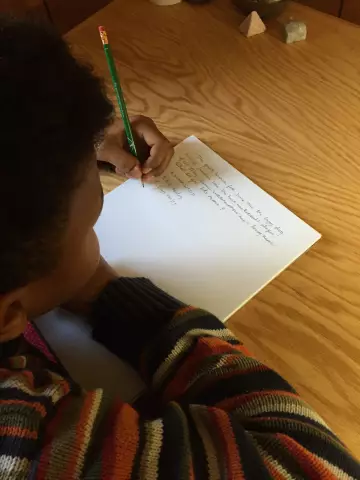- Author Rachel Wainwright [email protected].
- Public 2023-12-15 07:39.
- Last modified 2025-11-02 20:14.
How to help a child with dysgraphia: 8 tips for parents
Dysgraphia is a persistent writing disorder due to impairment of mental functions that regulate the ability to learn to speak and write. Deviation is manifested by typical, constantly repeated mistakes, from which a person cannot get rid of on his own. Dysgraphia is very common: it occurs in 53% of children aged 8-8.5 years and in almost 40% of secondary school students. And we are not talking about ugly handwriting, sloppy writing or violations of spelling rules and regulations.
We will help parents understand if their children have a tendency to dysgraphia, and tell you about ways to correct it.

Source: depositphotos.com
Don't ignore the problem
Many parents find that their child is not very good at learning writing skills and blame the “inattentive” teachers. And in vain. Dysgraphia in babies, as a rule, subsequently develops due to the influence of various factors at a much earlier age. Among them:
- intrauterine malformations;
- birth trauma or asphyxiation at the time of birth;
- severe infectious diseases (encephalitis, meningitis and other diseases that exhaust the nervous system);
- brain tumors;
- mental retardation;
- speech disorders.
At risk are children whose parents have a small vocabulary, have fuzzy or incorrect speech, or simply do not bother communicating with the baby. Oddly enough, dysgraphia also occurs in those with whom they studied too actively before entering school, forcing them to assimilate information that is too difficult to perceive.
If you have dysgraphia, you should not hope that the child will "outgrow" the problem. Persistent violations of the letter, not associated with ignorance of the rules of spelling, require correction with the participation of a psychologist, speech therapist, teachers and, of course, parents. In addition, some patients need the help of a neurologist, otolaryngologist, rehabilitologist, etc.
Be patient
Abundant and elementary mistakes in writing that a child with dysgraphia makes, as a rule, annoy adults, especially since a feature of dysgraphia is persistent repetition of the same mistakes. The most common are the following:
- confusion in the spelling of letters that are similar phonetically ("g" and "k", "d" and "t", "b" and "p") or graphically ("w" and "u", "x" and "g", "L" and "m");
- writing capital letters instead of lowercase letters (and vice versa);
- mirroring letters;
- rearrangement of syllables in words;
- adding extra syllables or letters to words;
- lack of endings in words;
- inconsistency of generic, numerical and case endings;
- violations of the structure of the text, missing members of sentences.
Meanwhile, when dealing with a kid with dysgraphia, one should not rush and get annoyed. An adult should be aware of the fact that an elementary task for himself for a child is not. The presence of an angry and impatient mentor only makes the situation worse and increases the number of mistakes.
Organize a place of study
The child should practice in a well-ventilated and properly lit room. It is important that nothing distracts him: you need to turn off the computer and TV, remove unnecessary items from the table, if possible, ask other family members to leave the room. Particular attention should be paid to furniture and office supplies: a table, a chair, as well as a pen or pencil, which the kid writes with, should be as comfortable as possible.
Avoid Overwork
A child with dysgraphia has not really developed a writing skill. Long sessions tire him out, which is why regular breaks of 10-15 minutes are necessary. At this time, he can run, drink a glass of juice or eat an apple, play. In no case should you combine work on the text with watching TV or playing a computer game: it will be difficult for the kid to concentrate.
Play with your child
Younger students learn more easily information presented in a playful way. There are many methods of teaching writing using puzzles, riddles, coloring pages, etc. Of course, they need to be selected individually; about this it is useful to consult with a psychologist and speech therapist.
Speak problem words
Experts advise explaining the spelling of each word to the child in detail, repeating it out loud and clearly articulating the problematic points. It is important that the baby also pronounces the words that he writes in syllables. Each mistake should be corrected by repeating the word again. In this case, the matter is progressing slowly, but it is unacceptable to blame the child for lack of ingenuity: this can negate the entire effect of the classes.
Read aloud
The richness of the vocabulary, the general development of a person and the quality of his writing are in direct proportion to how much fiction he reads and how easily the named process is given to him. For children with dysgraphia, reading is usually problematic. It is difficult to correct the situation, since the attitude towards reading as a difficult, unpleasant and useless occupation has already been formed by the age of 7-8. But even in such a situation, you need to try to interest the child in books.
For starters, short stories or poems, funny, entertaining stories are suitable. You can not force the child to read and leave him alone with this activity. Better to arrange the readings aloud, one at a time or by role. Parents, on the other hand, should make sure that the baby carefully pronounces all the words and pays attention to their correct spelling.
Provide your child with moral support
With dysgraphia, it is difficult for a child to study at school. He experiences constant dissatisfaction from teachers and gets used to consider himself less successful than his peers. Yes, and classmates sometimes treat him without sympathy, scoffing at "stupidity", which further depressing and leads to a decrease in self-esteem.
In such a situation, only the love and understanding of the parents can correct the situation or at least reduce the severity of the problem. Adult family members should make sure that the baby receives all the necessary help (classes with specialists, diagnosis and treatment of existing diseases, a friendly attitude when completing assignments). It is important to praise your baby as often as possible, celebrate any successes and not scold for mistakes and failures.
According to experts, dysgraphia can be recorded in a child over 8 years old. By this time, the basic skills of writing are normally already formed. The presence of a problem is indicated by typical, obsessively repeating writing defects. They are almost always combined with a poor vocabulary, speech disorders, poor memory. In addition to dysgraphia, these children often have hyperactivity, poor performance, and difficulty concentrating.
The deviation is amenable to correction, but the degree of correction directly depends on the efforts made by loved ones. It is important to understand that dysgraphia never goes away on its own. The sooner the baby falls into the hands of specialists and the more carefully their recommendations are followed, the better the result will be. It is desirable that by the end of primary school the child has completely mastered the skills of writing; otherwise, problems with subsequent learning and social fulfillment are inevitable.
YouTube video related to the article:

Maria Kulkes Medical journalist About the author
Education: First Moscow State Medical University named after I. M. Sechenov, specialty "General Medicine".
Found a mistake in the text? Select it and press Ctrl + Enter.






